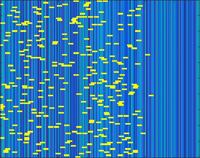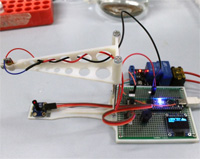Team:Sydney Australia/Modeling/Supplementary
Supplementary Material
Maintaining the ideal of open-source research, this page contains the source code for our various modelling efforts. Due to the computational complexity of some of these programs we did not have the time or expertise to produce web-interfacing tools for general usage. That said, for a user with MATLAB already installed these files can be downloaded and operated immediately.
TransOpt
The complete code for TransOpt is written in MATLAB1(requiring MATLAB2011 or later), and is available in the .zip file below:
The only file which need be run or altered by the user is TransOpt.m, which is the main procedure of the tool. From here the input sequence can be changed, as can the initial and heterologous expression hosts. TransOpt.m makes reference to a function frequency_optimise.m which performs standard codon harmonisation, the results from which are compared to the TransOpt result.
The input sequence must be set as a text file containing a sequence of the letters A,T,C,G which is a multiple of three in length.
The input GCNs (Gene Copy Numbers) for use in rate quantisation are included for the strains of Pseudomonas putida2, Mycobacterium smegmatis3, Escherichia coli4 as used in our project. In order to use the tool for different bacterial species, data can be downloaded from the Genomic tRNA Database5 and formatted as shown in (for example) pseudogcn.csv.
The tool removes iGEM restricted sites from the final mRNA sequence, with a list of these being stored in the badseq variable. If there are additional sites the user wishes to outlaw, they can be added to this list.
Visualisation Tool
The complete code for our visualisation tool is written in MATLAB1 (requiring MATLAB2011 or later), and is available in the .zip file below:
The only file which need be run or altered by the user is Visualisation.m, which is the main procedure of the tool. From here the input sequence can be changed, as can the expression host.
The input sequence must be set as a text file containing a sequence of the letters A,T,C,G which is a multiple of three in length.
The input GCNs (Gene Copy Numbers) for use in rate quantisation are included for the strain of Mycobacterium smegmatis3 as used in our project. In order to use the tool for different bacterial species, data can be downloaded from the Genomic tRNA Database5. Extending the tool to a different organism also requires replacing utilisation.csv, which is a file (decoded in readSubtracting.m) that reflects which tRNA bind with different codons (via standard Watson-Crick and wobble interactions).
The parameters alpha and beta, which define the hop-on and hop-off rates can be changed on lines 24 and 25 of the code respectively, which yields interesting changes in dynamics. In order to simulate different numbers of mRNA molecules within the cell, the variable mRNA_copies can be altered at the user's discretion. Setting mRNA_copies to one produces a different plot of the translation process, showing the ribosomes moving along a two-dimensional plot of translation rate.
ElectroStop
The source code for ElectroStop is written in the Arduino programming language6, and is available in the .zip file below:
This software can be run on any of the ATMega328 Arduino variants, but will obviously require the circuit and hardware that makes up the ElectroStop device, as described on the ElectroStop page. Programming an Arduino device with this software will require the Arduino development software version 1.6.5 or later6, as well as the Adafruit SSD13067 and GFX8 libraries.
The 3D models for the two 3D printed parts of ElectroStop are provided in the .zip file below:
This .zip includes .step files for each structural part, which can be opened by most common 3D modelling applications. It also includes .stl (Stereo-Lithography) files, which are used widely in 3D printing, and can be uploaded directly to most 3D printers for immediate manufacturing.
References
1 MATLAB, 2015, “MATLAB - The Language of Technical Computing”, http://www.mathworks.com/products/matlab/.
2 Genomic tRNA Database, 2014, “tRNAscan-SE Analysis of Pseudomonas putida KT2440”, http://gtrnadb.ucsc.edu/Pseu_puti_KT2440/.
3 Genomic tRNA Database, 2014, “tRNAscan-SE Analysis of Mycobacterium smegmatis MC2 155”, http://gtrnadb.ucsc.edu/Myco_smeg_MC2_155/.
4 Genomic tRNA Database, 2014, “tRNAscan-SE Analysis of Escherichia coli K12”, http://gtrnadb.ucsc.edu/Esch_coli_K12/.
5 The Genomic tRNA Database, 2014, http://gtrnadb.ucsc.edu/.
6 Arduino, 2015, “Download the Arduino Software - Version 1.6.5”, https://www.arduino.cc/en/Main/Software.
7 Adafruit, 2015, “Download the Adafruit SSD1306 Library”, https://github.com/adafruit/Adafruit_SSD1306.
8 Adafruit, 2015, “Download the Adafruit GFX Library”, https://github.com/adafruit/Adafruit-GFX-Library.



